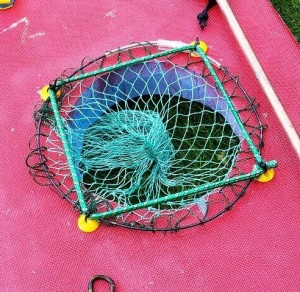So yesterday I joined a boat dive. FreediveUK were taking out a couple of AIDA 2* students and they sometimes take previous students out to get a bit more practice. There were two main reasons why I joined the boat trip; firstly to get some depth experience. It is difficult to find deeper water shore diving where I live so since my course none of the dives I have done have been more than about 10m. Secondly I was sold on the great visibility they are getting down in Cornwall at the moment. I haven’t experienced more than about 5m since I qualified and I was looking forward to being wowed out by the clarity.
Unfortunately only one of these was achieved, I got some extra depth but the weather was atrocious and the viz was some of the worst I have seen (do you see poor viz, or not see it?), in fact it couldn’t have been worse, at the surface you could barely see your hand at arm’s length, beyond about 12m was darkness!
This trip was also an opportunity to get used to my new freediving watch, the Sporasub SP1, but more of that later.
The second site that the knowledgeable dive boat skipper (Mark from Atlantic Scuba) found was just calm enough, and deep enough to drop the rope to 16m. As soon as we got into the water and I saw how poor the viz was I had quite a deja vu for my own 2* course, over a year ago in that cold dark quarry. The first few free immersions down to about 10m were fine, but when it came to clipping on the leash and diving down the rope I got all tangled again and faced the embarrassment of not being able to achieve what the other two guys were about to do.
It is funny how a few extra things to think about make it so much more difficult. Where previously I have been building confidence with every dive, suddenly I felt like I was back to square one, a few seconds aligning myself with an almost invisible rope, trying to pinch my nose with the hand to which the leash was attached, and suddenly I hadn’t equalised properly. It all started feeling a bit alien and before you know it I had turned at 8m, a depth that last week I was doing without even thinking about it.
Luckily while they were going through their drills with the instructor I had a practice doing some variable weight dives with the dive-master. This is simply holding on to a heavy weight whilst he controls the descent of rope over the first critical couple of meters, then he lets it drop. The prospect of descending at rate over which you have almost no control is slightly daunting the first time, but as soon as you feel any discomfort you can just let go, the weight speeds to the bottom and you pull yourself up on the rope as usual. The advantage of this practice is that it removes all factors from the equation apart from equalisation. You don’t have to move, fin or worry about anything else. It came surprisingly easy and was a real confidence booster, especially at depth, when it suddenly became so dark you couldn’t see any contrast in the light at all, and the only way of knowing where was up was the direction of the rope.
My watch told me that I was mostly dropping the weight around 12 or 13m, I think this was due to slightly painful sinuses, and proved I needed to maybe descend more slowly. I’m not sure if this kind of descent is suitable for very new beginners, if you don’t know how well you equalise, or aren’t aware of the warning signs then you should probably be careful.
As soon as I got back on the other rope I finned straight down to 16.4m (couldn’t see the plate at all!) and came slowly back up all nice and comfy, no problems, relaxed descent, and much more relaxed in the darkness.
The things I learn’t from this trip were:-
1/ I have to admit I’m really not comfortable yet at depth in very low viz. My lungs give me all the time in the world, and in clear water I am happy to stop and hang around for 10 or 15 seconds to equalise, get my bearings, align to a rope, (or just look at fishes), then carry on. But as it gets darker I will turn at the slightest hint of a problem, I’ll overcome that and yesterday was a confidence booster.
2/ The first dive or two of the day beyond about 8m result in an immediate urge to breathe, my body subconsciously thinking I need to breathe because my lung capacity has quickly halved (nearly) these contractions, (just like when you do breath hold practice) interfere with equalisation and cause confusion. That feeling goes away after the first couple of dives and this helps with keeping calm and no longer interferes with equalisation.


